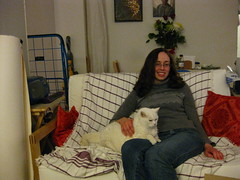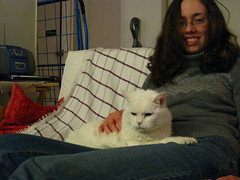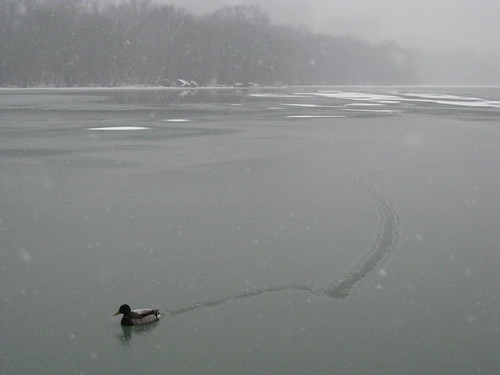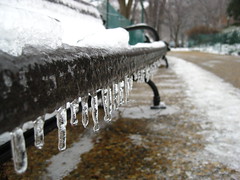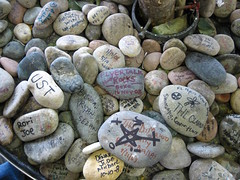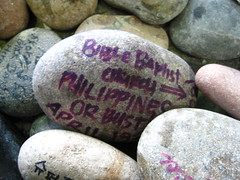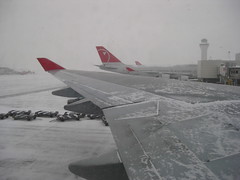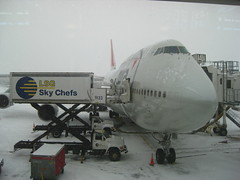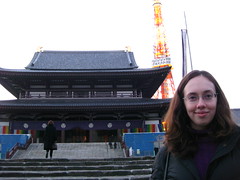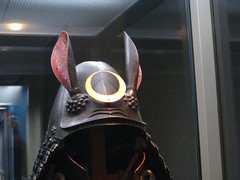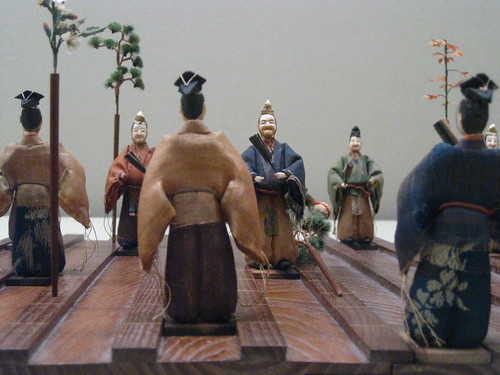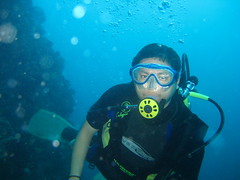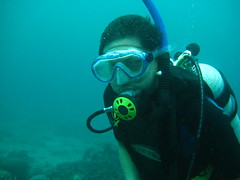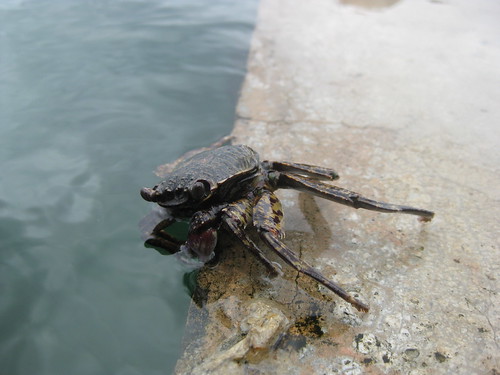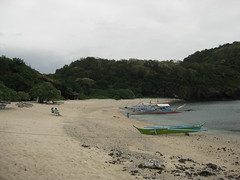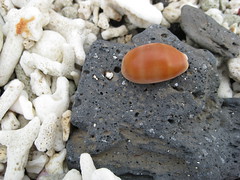We haven’t had any cat photos for a while, so here’s a few. Got these cat-and-Amy photos last week with a new camera, a Canon Powershot SD770 to replace the SD1100. More on why I needed a new camera so soon in an upcoming entry.
Duck and Ice
Above, a duck leaves an icy trail in the Potomac River by Washington Harbour during the first real snow of the winter on January 27th. After about 1-2 inches of snow, we then had a lovely little ice storm the next day which turned the city into something very like a skating rink, which made the walk to work quite fun.
Scenes From the 2009 Inauguration of President Obama
Amy and I were joined by jclements on the morning of January 20th. Despite living near the Capitol, entering the open expanse of the National Mall from there would have meant squeezing through an impossibly crowded bottleneck between the borders of the inaugural parade route and the ticketed standing areas. Instead we walked as far west as 19th St NW before we found a way onto the Mall that had not been choked off by masses of humanity. The city was, of course, a mess, and every street corner had turned into a mini-bazaar of electoral and inaugural memorabilia.
From 19th St NW we managed to head down Virginia Ave NW right up to the Washington Monument, where we stood near the Monument’s base, within sight of three jumbotrons. It was cold, but worth the walking and shivering to be shoulder to shoulder with fellow Americans to see history, even if from a crowded, far-off hill, through speakers and jumbotron screens. Then we went to Georgetown and had burgers.
More photos here, along with the days leading up to the event — including a sighting of Sir Ian McKellen at the Reynolds Center during a MetaFilter meetup.
Christmas 2008 and New Year 2009 Holiday Travel Roundup
Holiday in Transit: Planes, Boats, Cars, Trains from brownpau on Vimeo.
I should really write my travel logs on the fly so I get them out of the way faster, rather than taking weeks to finish like this. I’ve had to backdate my latest entries to avoid the archived embarassment of having my travel entries for two weeks stretch between two months. Also, I need a better naming convention for my New Year trips because “Christmas 2008 and New Year 2009” is just way too long.
In a nutshell:
Travel log entries
- NJ Christmas 2008
- On the Fly: EWR-DTW-NRT-MNL
- Tito Cesar
- Stuff We Did in Manila
- Greenhills Elan Hotel
- Eagle Point Resort
- Anilao Dive Log
- Stuff We Did in Tokyo
- Oak Hotel
- A Few Tokyo Travel Tips
- DTW Planter Stones
Photosets:
DTW Planter Stones
Have you left a message on the stones in the planters at Detroit Airport? Note the Flyertalk Rock by a forum member.
Also of passing interest, our snow-covered NWA 747-400 after arrival:
A Few Tokyo Travel Tips
First, let’s set the mood with a video from the Keisei Skyliner:
Now, a few things we learned along the way:
- If, like us, you’re coming from a longer trip elsewhere and carrying lots of stuff that you won’t need for while you’re in Tokyo, Narita Airport has bag storage facilities which will keep your suitcase or duffel of “unneededs” safe in storage for about 500-800 yen per bag per day. There’s one at departure and one at arrival in each wing of the airport.
- At immigration into Japan, visitors are supposed to get a digital fingerprint scan by pressing two button scanners with their index fingers. Thousands of people from all over the world press their unwashed index fingers onto those scanners every day. I forgot that, rubbed my eyes, and was rewarded with a lovely case of conjunctivitis that night. On a related note, Tokyo medical info site Himawari led me to Ueno Eye Clinic, right around the corner from Ueno Station. That map belies how difficult it is to actually find the clinic; it was purely by luck that we found it after several minutes of walking past side streets and alleys not shown in the image.
- At the clinic, desk staff and nurses didn’t speak much English, but they had the necessary papers, and gave me a sheet for me to tick off symptoms, and a medical card with my name transcribed into Hiragana. I didn’t wait long at all, and the doctor, a friendly woman with good English who had lived in Nashville for a time, checked my eyes and prescribed two eye drops, an anti-inflammatory and an antibiotic, which we picked up at a neighboring pharmacy. Total cost: about 6,400 yen, out of pocket. That’s cheap. My eyes were fine for the rest of the trip.
- If you visit Tokyo Tower, be sure to also drop by Zojo-ji, the Temple beside the Tower. It was the family temple of the Tokugawa Shogunate, and is still adorned with their crest. Inside, rows of seats face the shrine so you can watch Jodo shu Buddhist monks in their chants and ceremonies without disturbing them. I found this a far more peaceful and authentic cultural experience than the more chaotic and tourist-trappy environment around Senso-ji.
- If you’re coming from Keisei Ueno station, are pulling large rolling bags, and are going to somewhere along Asakusa-dori, ignore any directions that say to go through Ueno JR station, and instead take the sidewalk and bear right around the station building. Walking through Ueno Station means dealing with both stairs and crowds of commuters while hauling a huge suitcase all over.
- Almost no one takes credit cards, except when buying stuff at Yodobashi and some of the other large electronics stores in Akihabara, so have lots of cash handy.
- If you eat at Tenryu in Ginza, it is customary to order the gyoza, their signature dish. We missed it.
That is all. We now close with the Jodo shu Buddhist monks of Zojo-ji chanting the nembutsu:
YOU ARE NOW BUDDHIST.
I kid.
Oak Hotel
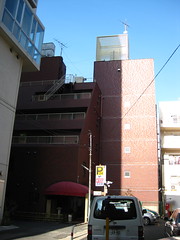 Rather than a cheap hotel with small rooms, it’s much better to think of Oak Hotel as an upscale backpackers’ hostel with private rooms for rugged compact urban living, which is how they position themselves. Oak Hotel’s terraced brick building is nestled into an alleyway in Taito City, just ten minutes’ leisurely walk down the left side of Asakusa-dori from Ueno Station and Keisei Ueno (or just a few steps from Inaricho Metro station on the Ginza line).
Rather than a cheap hotel with small rooms, it’s much better to think of Oak Hotel as an upscale backpackers’ hostel with private rooms for rugged compact urban living, which is how they position themselves. Oak Hotel’s terraced brick building is nestled into an alleyway in Taito City, just ten minutes’ leisurely walk down the left side of Asakusa-dori from Ueno Station and Keisei Ueno (or just a few steps from Inaricho Metro station on the Ginza line).
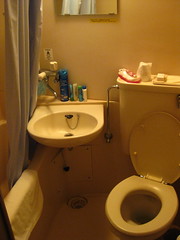 I really wanted to like Oak Hotel. I loved the novelty of the tiny rooms and the even tinier bathrooms where you had to hunch to avoid bumping your head against the low ceiling in the shower. I loved the TV with just Japanese broadcast channels and their whimsical variety shows and shrill anime and samurai dramas. I loved the close proximity to the Metro and Ueno Park and Ameyokocho and Asakusa and Akihabara, with our pick of dozens of konbini and eating places right nearby. I loved how, when we checked-in, they asked me if I had a laptop, and when I said yes, they immediately gave me a bag with a cable modem and router in it (complete with amusingly translated Engrish manual) so I could plug into fast broadband internet right from our room. I loved that the staff were polite, friendly, accommodating, and fluent in English. And if we had stayed longer, I would have loved the downstairs informal common areas where you could eat and mingle with other visiting guests.
I really wanted to like Oak Hotel. I loved the novelty of the tiny rooms and the even tinier bathrooms where you had to hunch to avoid bumping your head against the low ceiling in the shower. I loved the TV with just Japanese broadcast channels and their whimsical variety shows and shrill anime and samurai dramas. I loved the close proximity to the Metro and Ueno Park and Ameyokocho and Asakusa and Akihabara, with our pick of dozens of konbini and eating places right nearby. I loved how, when we checked-in, they asked me if I had a laptop, and when I said yes, they immediately gave me a bag with a cable modem and router in it (complete with amusingly translated Engrish manual) so I could plug into fast broadband internet right from our room. I loved that the staff were polite, friendly, accommodating, and fluent in English. And if we had stayed longer, I would have loved the downstairs informal common areas where you could eat and mingle with other visiting guests.
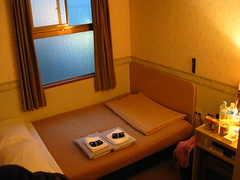 I loved all that, but the room itself was so dusty that it was unlivable. As soon as we walked in we began coughing, and it only got worse when we turned on the heat and ventilation. We couldn’t even sleep from coughing, though we found some relief when we reversed position so our feet faced the headboard, and opened the windows to let in some clean — but freezing — air. A quick tissue-wipe of the headboard came up worryingly dirty, and items left on the desk for the day accumulated noticeable quantities of particulate matter. I don’t know if it was ambient dust in the building or air pollution (not likely since the outside city air coming in through the window was actually cleaner) or some other factor, but the allergens in the air were so thick that we tried to stay out of the room as much as possible, because almost every moment in the room was spent in a miserable state of what felt like mild but constant anaphasic shock. We breathed fine as long as we were outside. This meant we didn’t get to sleep much — a situation not helped by the sounds of coughing from other guests in the building. (I didn’t mind the thin walls, as these were to be expected, but they did broadcast to us the aural evidence that we were not alone in our bronchial woes.) I really don’t get it because the room was well-kept and cleaned everyday, but the dust in the air remained intolerable.
I loved all that, but the room itself was so dusty that it was unlivable. As soon as we walked in we began coughing, and it only got worse when we turned on the heat and ventilation. We couldn’t even sleep from coughing, though we found some relief when we reversed position so our feet faced the headboard, and opened the windows to let in some clean — but freezing — air. A quick tissue-wipe of the headboard came up worryingly dirty, and items left on the desk for the day accumulated noticeable quantities of particulate matter. I don’t know if it was ambient dust in the building or air pollution (not likely since the outside city air coming in through the window was actually cleaner) or some other factor, but the allergens in the air were so thick that we tried to stay out of the room as much as possible, because almost every moment in the room was spent in a miserable state of what felt like mild but constant anaphasic shock. We breathed fine as long as we were outside. This meant we didn’t get to sleep much — a situation not helped by the sounds of coughing from other guests in the building. (I didn’t mind the thin walls, as these were to be expected, but they did broadcast to us the aural evidence that we were not alone in our bronchial woes.) I really don’t get it because the room was well-kept and cleaned everyday, but the dust in the air remained intolerable.
So yeah, great location, outstanding service, friendly staff, cheap price, free fast internet, but if you have allergic reactions to lots of dust, maybe don’t stay here, or at least don’t stay in Room 214.
Stuff We Did in Tokyo
We visited an eye clinic. We took in the view from Tokyo Tower. We drank hot cans of Cafe au Lait while sitting by the waterfall in Shiba Park. We entered Zojoji Temple and listened to the chants of Jodo shu Buddhist monks. We walked through Ueno Park and viewed artifacts at the Tokyo National Museum. We strolled up and down Kappabashi-dori to buy little bowls and gawk at plastic food samples and a gold kappa statue. We browsed the stalls of Nakamise-dori and stood before Sensoji Temple. We wandered around Ginza and Asakusa and Akihabara till our feet were tired. We shopped at Yodobashi but didn’t find much. We ate tempura at Tenya and Japanese-like Chinese food at Tenryu and soba noodles at the Ueno JR. Tokyo is huge and sprawling and local TV is a hoot and people tend to eat at counters rather than tables and you bring your check to the cashier rather than paying your waiter and there sure are lots of bicyclists and vending machines and bowing and subway lines. We had fun in Tokyo — but I wish more places there took credit cards.
Anilao Dive Log
My family went on six dives spread out over three days but I only went on two of those dives on the second day, opting to keep Amy company at the resort on the first and third days.
Date: 1 Jan 2009
Location: Sepok Wall
Maximum depth: 85 ft
Dive time: 50 minutes
Air used: 2500 psi
Off the northwest tip of Maricaban Island, Sepok Wall starts as a flat reef at 20 feet, from where the gently sloping sea floor forks off and descends down to 80-100 feet, forming a wall teeming with coral and fish. There’s usually a moderate current in the area (my first time there, I was swept off the reef by a fairly strong flow) but that day it was mild, and cancelled out in the shallows by surface swell. I got to see a baby banded sea snake, a moray eel, and a mantis shrimp.
One equipment issue plagued me later in the dive — I had not used enough weight. As my air ran out I found myself tending to float upwards even when fully exhaled, and had to fight more and more to stay down, expending more air in the process. Towards the end of the dive, out of air and unable to maintain neutral buoyancy, I had no choice but to shoot up through my safety stop and fin back to the banca to rest. The really painful thing about this is that it means I’ve gotten fatter since last year, when I used the same amount of weight.
Date: 1 Jan 2009
Location: Koala
Maximum depth: 45 ft
Dive time: 55 minutes
Air used: 2000 psi
After a surface interval with lunch, hiking, and snorkeling with Amy (her first time!) at Sepok Beach, we left Maricaban Island and crossed the channel back to the Batangas area, where we dove Koala, a beginner-friendly reef. Koala is easy and shallow, but fairly well-populated with wildlife: lots of anemones with clownfish, and this dive featured a high concentration of lionfish. My brother Javi also found a strange, cross-shaped starfish, its arms possibly mutilated in an altercation with other local fauna.
I carried enough weight this time, but failed to spit enough into my mask, so it fogged up far too often, necessitating frequent floods and purges — meaning further air expenditure. Still, I lasted longer than I did at Sepok, and managed a safety stop this time. (Koala is so shallow that most of the dive is practically a safety stop anyway.)
In retrospect I should have gone on the next day’s dives as well; as evidenced by the latter half of the above video, that was when the fish came out to play.
Eagle Point Resort
Anilao (in Mabini, Batangas) has always been my family’s go-to spot for diving, ever since my parents’ scuba heyday in the 1960s. When I was a kid we had a nipa-and-bamboo house at a ramshackle, sparsely-amenitied bungalow resort called Seafari, from where we could launch a speedboat or hire a banca to take us to area dive spots. Today, Seafari is gone, and Mom wisely decided instead to book a resort which provided both diving and other non-scuba activities for Amy and my brothers’ significant others. So she picked Eagle Point Resort.
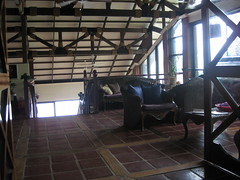 Somewhat isolated from the Anilao resort strip, the approach to Eagle Point starts in the hills of Bagalangit, further down Batangas Bay, branching off the main road to a narrow, winding jungle driveway leading to a parking lot, just the midpoint from where an Isuzu Elf shuttle takes you to the resort. From there, a clubhouse and open-air restaurant (called the Main Core) sits between two sections: the older cabana-and-cottage resort, and the more conventional Terrace Hotel, where we stayed.
Somewhat isolated from the Anilao resort strip, the approach to Eagle Point starts in the hills of Bagalangit, further down Batangas Bay, branching off the main road to a narrow, winding jungle driveway leading to a parking lot, just the midpoint from where an Isuzu Elf shuttle takes you to the resort. From there, a clubhouse and open-air restaurant (called the Main Core) sits between two sections: the older cabana-and-cottage resort, and the more conventional Terrace Hotel, where we stayed.
Eagle Point has a dive shop and staging area with concrete boat dock and equipment rental office, three swimming pools (two connected by water slide), a small aviary of native birds, and a a walled-in saltwater habitat by the bay, for snorkelers to look at coral, groupers, baby sharks, and other wildlife. The habitat is somewhat necessary for non-divers who want to get in the water and experience some of the local marine life, as the beach by Eagle Point is rather rocky and difficult to swim or snorkel from.
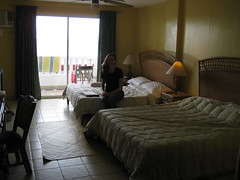 Our hotel rooms were furnished heavily with bamboo, large and clean, featuring open balconies facing the sea. I noted that some bed headboards fitted badly around building supports jutting from the wall, such that the headboards leaned awkwardly over the beds, but this was no great trouble. Housekeeping came to clean every morning, leaving two complimentary bottles of distilled water per room each day. A few cable channels come through via satellite, and there was even free wifi in the Main Core, though cloudy days tend to degrade signal. Bathrooms had hot water and a nice big shower area, which was very nice.
Our hotel rooms were furnished heavily with bamboo, large and clean, featuring open balconies facing the sea. I noted that some bed headboards fitted badly around building supports jutting from the wall, such that the headboards leaned awkwardly over the beds, but this was no great trouble. Housekeeping came to clean every morning, leaving two complimentary bottles of distilled water per room each day. A few cable channels come through via satellite, and there was even free wifi in the Main Core, though cloudy days tend to degrade signal. Bathrooms had hot water and a nice big shower area, which was very nice.
The resort has a divemaster and advisory dive instructor on staff, both old scuba veterans of the area. For experienced divers there were no stringent requirements; the divemasters checked certifications, gave recommendations, and helped out with boat and equipment rentals. Otherwise we were free to dive without need for supervision — a requirement we have run into at other times.
In addition to the main resort, Eagle Point has acquired Sepok Beach on neighboring Maricaban Island, where they’ve built a “beach center.” This location, about a thirty minute banca ride from Anilao and within view of nearby Sombrero Island, provides the sandy beach venue missing from the main resort. The area also features a few picturesque walking paths through light seaside jungle to other rocky beaches on the peninsula, punctuated by the ruins of earlier resort moorings.
We stayed for four days through New Year 2009. I tend to hate New Year in the Philippines, and this was no exception. Let’s just say that when you set up firecrackers and bottle rockets at a beach resort, common sense dictates that you point them out to sea for safety, not at the resort so the guests can see the explosions better.
Aside from that that and the somewhat gloomy weather through our stay, Amy and I enjoyed ourselves immensely. Lots to do for divers and non-divers alike, courteous staff, well-maintained pool, excellent food, and some very engaging birds at the aviary. Here, for example, are some toucans:
